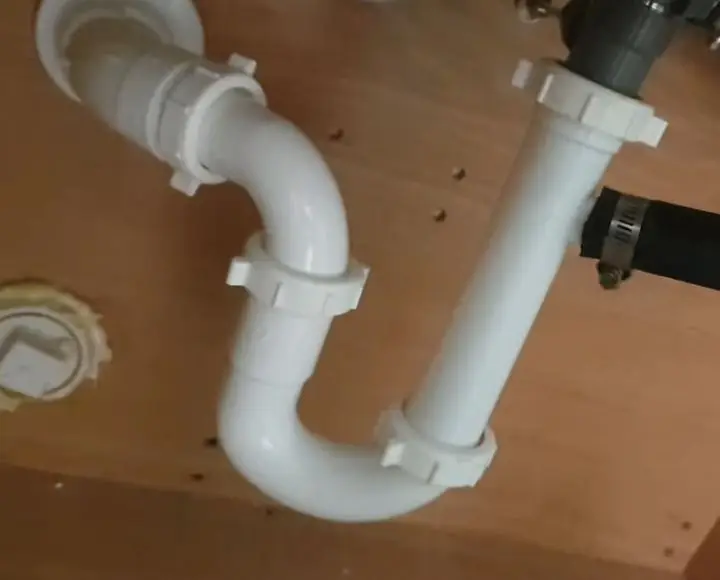If you look below your washroom or kitchen sink, you will notice a U-shaped pipe. But if you are not into plumbing, you might wonder what this type of bend is or its use. Some people are probably displeased with it since you find it to finish your storage space. This equipment is generally called the P-trap and is important to your plumbing system.
What is a Reverse P-Trap? It’s a plumbing fixture used in drains to prevent water from flowing backward and out. Simply put, a reverse P-trap comes when you install a P-trap in reverse. A P-trap is a U-shaped pipe below your bathroom or kitchen sink. The P-trap is connected to either the bathtub, sink, or shower, receives wastewater, and then directs it to the drainage system.
A P-trap should be installed carefully because of its great use in the plumbing system. Improper installation can cause problems to the sink, like clogging or water and sewer gases flowing backward. The curve or bend of the P-trap collects water to form a 1½ to 2-inch water barrier that prevents odor and toxic gases from entering your home.
What’s The Importance of a P-Trap?
These are the major reasons why a P-trap is significant to your drainage pipes. Some of those include the following:
- Plumbing codes require a P-trap for introducing any points. You should, however, ensure that the trap is properly tightened and sealed to prevent leaks.
- A P-trap stops bad gases from going back through the channel line to your sink and home. When you close your tap, the water doesn’t drain away; some remain in the P-trap bend. The water then seals off smelly sewers or toxic gases from escaping backward.
- It traps solids and prevents clogging of the sewer or channel line. In case of clogging, unscrew the P-trap, clear all the debris, clean it, and fix it. A clogged P-trap is far easier to deal with than an obstruction deep down the drainage system, as you will need the help of an expert plumber.
Can a P-Trap Go Both Ways?
Even if a P-trap is designed to go both ways, it’s not usually advisable as it can fail to stop sewer gases. However, if you have no other option but to reverse the P-trap, you should lower the drain by some inches into the wall, which isn’t easy. It can get harder if you have waste disposal beneath the sink.
For example, if your P-trap has slightly lower features, you may fail to get the appropriate slop for draining the waster water. But if you have assembled all the necessary pieces but cannot make a P-trap under your sink, try the below exceptional solutions.
Unconventional Solutions
For reverse P-traps to work properly, you must add special fittings. You may use these methods;
- Use a 1½ inch ID coupling to a 1½ inch OD and a threaded connection that accepts a tapered ring, then install the gizmo after the reverse P-trap. By doing so, you can achieve the 2 inches gap.
- Alternatively, you can use a metallic P-trap, although you will have a ½-inch grip on the trap’s short end.
- Make your P-trap from PVC or ABS pipe but don’t use the usual P-trap kit
- Do it practically; open the wall up and lower the drain
Can a P-Trap Be Turned Backward?
Yes. The two ends where the P-trap is fixed to your sink drainage pipe can be rotated to whichever side you deem fit. When installing a P-trap pipe, ensure the wastewater outlet point is lower than the inlet point. The minimum measurement for a trap seal is 2 inches, but building regulations set the maximum to 4 inches.
Nevertheless, using a reverse P-trap can create a trap seal of more than 4 inches which is a possible cause of clogging. This explains why many homeowners don’t like reverse P-traps. On the other hand, a trap seal with a diameter that’s less than 2 inches lacks defensive power from gas pressure.
Is There a Difference Between the P-Trap and a J Bend?
It can be difficult to differentiate the traps since they look similar. Moreover, they perform the same functions of forming a water seal that keeps away sewer gases, and both are International Plumbing Code-compliant. However, the J-trap doesn’t have a horizontal arm connecting it to the drain pipe and has a captive nut on its shorter arm. The P-trap includes 2 removable nuts and a horizontal arm.
What’s the Recommended Way to Turn a P-Trap?
During assembly and mounting of the P-trap, you should cement the 90-degree part onto the unbent side. Similarly, mount the curved part to your sink or shower outlet. But take care not to damage the drainage when gluing the P-trap.
Is a P-trap Required to Have Water?
A P-trap connects your sink wastewater to the municipal sewer line or your home’s septic tank. P-traps should contain water if your sink is working properly. The water acts as a barrier between the air in the home and the sewer, preventing wastewater gases from infusing back into the house.
A P-trap without water will thus not work properly, and you risk exposure to sewer gases. This happens when you don’t run water in the sink or shower drain for long periods, which makes the collected water evaporate. It can take a month or two before the water can completely dry out.
Although reverse P-traps can drain wastewater, you must make a few structural changes for effective results. A properly fitted P-trap should have a lower outlet than its inlet to allow wastewater to flow in one direction. The trap is ideal where you will likely experience water backflow, like in sinks. Other benefits include trapping solids and backflow of sewer gases.
